Starting a blog is perhaps one of the best things you can do to elevate your career and propel your earnings.
Whether you want to satisfy your passion or you want a side income or you want to start a business, starting a blog is a very good idea.
But how to start a blog and attract a lot of people on our blog and earn money from it?
This is exactly what we’re going to look at in this ultimate guide rather than seeing how to buy a domain name and hosting plans.
- Step 1: Find a Perfect Niche
- Step 2: Choose A Blogging Platform
- Step 3: Find A Domain
- Step 4: Choose a Web Hosting
- Step 5: Starting a Blog on WordPress
- Step 6: Installing WordPress Theme
- Step 7: Installing Plugins
- Step 8: How To Write Content
- Apply AIDA Formula:
- Step 9: Setting Up Google Analytics
- Step 10: Setting Up Google Search Console
- Step 11: How to Make Money?
- Bonus: Search Engine Optimization
- Conclusion:
We’re assuming you’re a complete beginner and we’ll take you to step by step from start to a point where you will know what to do with your blog.
Please note that the topics mentioned in this article are very broad in themselves. Discussing each of them in complete detail will make this article extremely long and tedious to read.
Step 1: Find a Perfect Niche
Some people call it passion, while some others call industry.
But when it comes to blogging, passion is the only thing that can keep you fueled in the long run.
Find your passion. Ask yourself what it is that you can always do without getting tired, what it is that you can talk about nonstop.
Before you learn how to start a profitable blog, you must first find your niche.
It can be:
- Books
- Movies
- Fashion or Makeup
- Cricket
- Wildlife or Pets
- Cooking
- Yoga or Exercise
- Smartphones
the list will go on and on without end.
You just have to find what’s yours.
Once you’ve figured out your answer, it’s time to start the blog.
Step 2: Choose A Blogging Platform
At this point, you first need to decide on which blogging platform you’re going to start your blog.
There are two options in front of you Hosted and Self Hosted. I recommend you to start a blog on the self-hosted blog because you’ve full access to the platform and custom domain name.
Check: WordPress.com vs WordPress.org: What’s the Difference
Going with free platform bound you with certain limitations, for example, using their domain name and operating on their terms and condition.
Remember, If you’re serious and want to achieve long term goal, go with a self-hosted platform like WordPress.
1. Free Platform
For many new bloggers, investing in self-hosted platforms is pretty challenging. The most popular free platform is Blogger by Google.
By creating an account on blogger, you have to use their domain name and customization options are also very less.
There are other platforms as well, such as Wix, WordPress.com, Tumblr, Medium, etc.
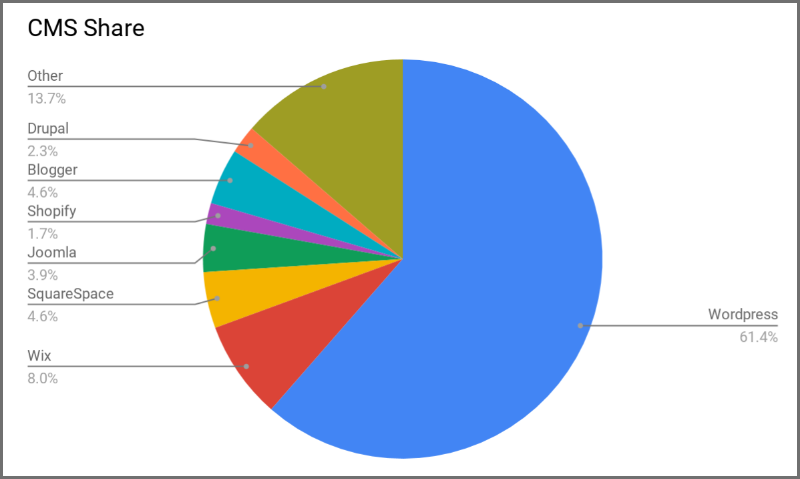
2. Self-Hosted Platform
The biggest benefit of using the self-hosted platform is that they allow you to run a blog with a custom domain and you have full right of your property.
To do so, you have purchase hosting and install CMS like WordPress.
WordPress.Org is one of the popular CMS in the world used by more than 27+ million websites.
I would recommend buying Bluehost Hosting or A2Hosting
Step 3: Find A Domain
Your domain name should resonate with your field of blogging and should be short and easy to remember.
If the domain you choose is already taken, then try something else.
I would recommend buying Top Level Domains (TLDs) such as .com and .org. TLDs are easier to rank globally and have a high trust factor.
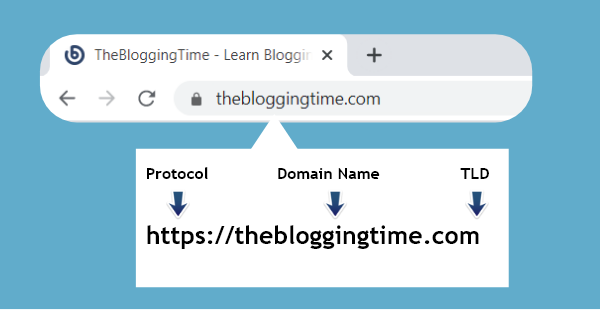
If you’re a brand or a company then buying a fresh domain is your limitation but if you’re running after some food or fashion blog then you can also try buying an expired domain.
Once you’ve decided, research your domain and follow some steps to create your account on the domain provider, make the payment, and then the domain is yours.
Follow this guide to know how to buy domain name from godaddy.
Step 4: Choose a Web Hosting
In most simple words, a web hosting provider is a company which gives you all the tools and services needed to build your website/blog.
There are many web hosting companies in the world and you can choose one of them based on the budget and services you need.
Buy Bluehost Hosting
Fastest Web Hosting + FREE Domain Name
Most popular ones are Bluehost, and a2Hosting.
Their services more or less are the same.
Their yearly charges range between 40$ to 80$ a year, and you can save more by opting for two or three years.
Check: How to Buy Web Hosting from Bluehost
Many hosting providers also have free services, but if you want to have some credibility, then go for a paid plan.
First of all, a paid plan will allow you to have your own domain and not something like websitename.host.com.
If you are passionate about starting your blog and make money out of it then, go with a paid plan.
Benefits of Good Web Hosting:
- High Site Performance
- Daily Backup
- Security
- High Uptime
- Priority Support
Some Good Hosting Plans
- Bluehost – $3.95/month
- Siteground – $3.95/month
- A2Hosting – $2.99/month
- InMotionHosting – $2.95/month
Moreover, you can check my web hosting checklist.
Step 5: Starting a Blog on WordPress
Almost all leading hosting companies let you install wordpress with just one click.
Once you click on “Install WordPress”, you’ll be asked to choose the domain (the one you’ve just purchased).
The installation takes some time, and after that, you’ll be asked to log in and will be taken to the WordPress dashboard.

Why WordPress?
Please note that we’re talking about wordpress.org. It is not wordpress.com.
WordPress.org is what you need to start a blog on WordPress and it has more features than wordpress.com.
WordPress.org is actually a Content Management System, also called CMS.
It’s extremely powerful, smooth, and provides attractive designs and tools to build a fully functioning website without having to Code.
To know more about the difference between WordPress and Wix, see this article from Bluehost.
Step 6: Installing WordPress Theme
When you first get into your wordpress dashboard, you’re provided with a default theme.
For detailed guide: How to Install WordPress Theme?
You can choose any other theme from thousands of free themes available. To do this, click on ‘Appearance’ and then ‘Themes’.
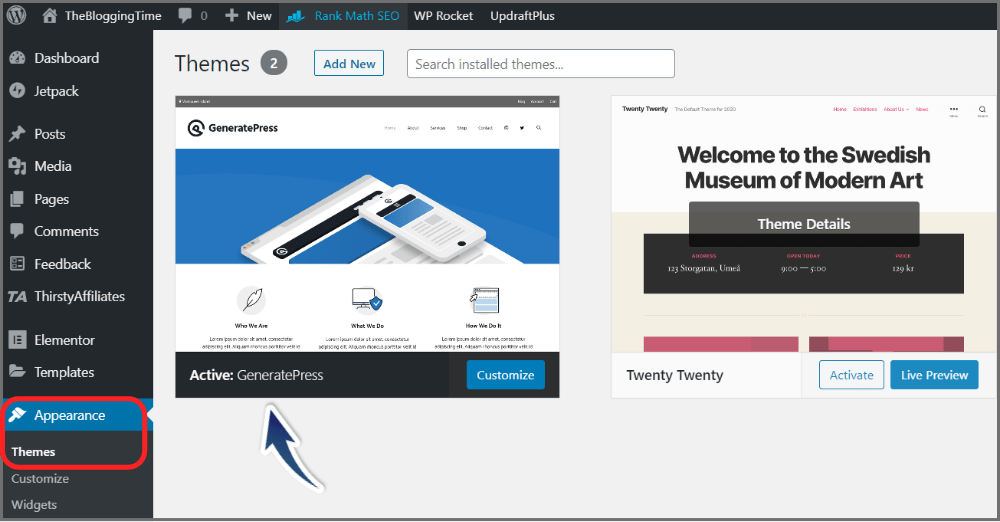
Each theme has different features, and it’s good to look around and see what fits your blog the best.
As a bottom line, when choosing a theme, you should consider:
- The feature to create multiple menu options
- Top bars, footers, sidebars
- Option to create a landing page
- Responsive
- Regular updates
To know more about the best free wordpress themes, see below article.
Paid themes have more features and they look more professional as compared to free themes. The costs normally vary from 35$ to 199$.
I am personally using Generatepress on most of my blog and trust me it’s one the best WordPress theme.
If you do not have the budget, you can start your WordPress blog with a free theme.
Step 7: Installing Plugins
Plugins are also very important as they add crucial functionality to your blog.
For detailed guide: How to Install WordPress Plugin?
What is a Plugin?
Typically, a plugin adds an extra feature to your WordPress blog without any coding knowledge. Let’s take an example.
Suppose you want to add a table of content to your nicely written blog post.
In that case, by adding plugin all that happens automatically without adding manual heading tags and linking them to each other.
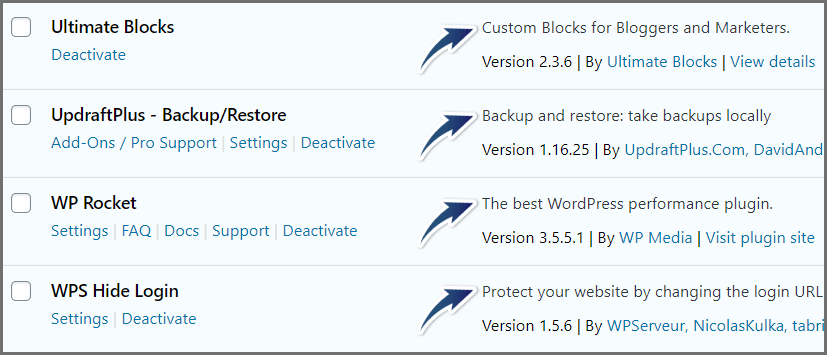
Some of the top plugins which you must install are:
- Social Snap: This allows you to add the social sharing links to your blog posts.
- Yoast SEO/ Rank Math SEO: It analyzes the SEO compatibility of your blog and suggests the improvements.
- WP Forms: It helps your readers contact you if they need.
- Elementor: It allows you to create stunning landing pages and helps to generate leads.
- W3 Total Cache/ WP Rocket: It enhances the speed of your website so they rank better in search results.
- Updraft Plus: It automatically takes backup of your website. Also, helps in restoring backups.
Click on the button above to know more about best WordPress plungins.
Step 8: How To Write Content
Now that we have started the blog with basic settings, it’s time to start writing.
Keep in mind to create your own content.
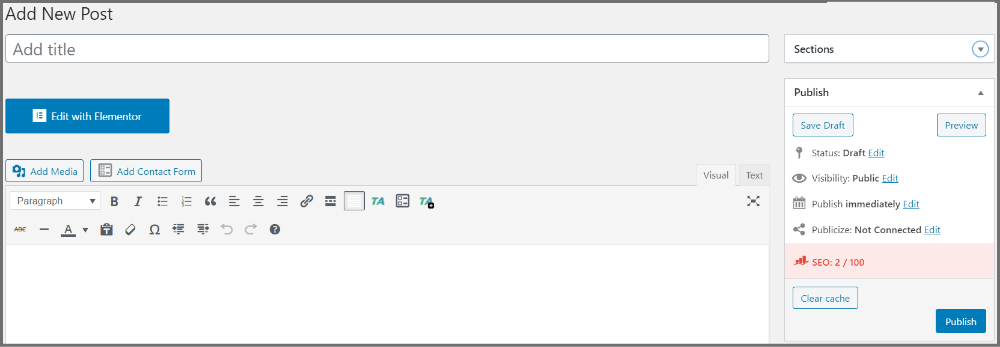
Authenticity is a must when it comes to writing something online. Avoid copy and paste from other sources.
Search engines can easily detect copied contents and can even de-index your website if you do so.
There are many plagiarism checker sites where you can check if your content is unique or not.
Now let’s see how to write content for your blog:
1. Brainstorming Ideas:
What to write? To answer this question, look at the field you’ve chosen. Think of what topics people want to read about.
Think of the problems people face, and see if you can provide them with a detailed solution. Look at the current trends, and consider if you can provide an opinion.
2. Titles:
Writing titles of a blog post is different from writing titles of an essay.
Here, you have to grab the attention of your readers the moment they see the title. It should fill them with, “wow! This looks interesting, let’s read this out”. Some common types of titles are:
- “How to” Headlines: For Example: “How to make YouTube videos”
- “Certain Number of Things” Headlines: For Example: “’15 things to do when you feel bored”
- “Tips and Lessons” Headlines: For Example: “20 life lessons to live a happy life”
- “How to” Headlines: For Example: “How to make YouTube videos”
3. Writing The Post:
To write a blog which looks neat, keep in mind the following points:
- Try to write in short paragraphs. Generally, 3-4 lines or less are good.
- Add suitable subheadings.
- Try to write comprehensive guides. Search engines value long content.
- Choose the font and sizes which are easily readable.
- While taking references from another blog, provide a suitable link to it.
- Add images. Go with the theory of, ‘A picture tells a thousand words.
Apply AIDA Formula:
AIDA is a very successful formula when it comes to writing on the internet. Its full form is Attention, Interest, Desire and Action.
- Attention: Your headline should attract the attention of viewers and make your blog stand out.
- Interest: The opening paragraph should pique the interest of the readers. Make sure it delivers what the headline has promised.
- Desire: Write in a way that makes them want to read till the end.
- Action: Don’t finish your blog in a dead end. If there’s any other blog you’d like them to read, provide with a Read More button.
Step 9: Setting Up Google Analytics
Analytics is important for various reasons. First, it will tell you what’s happening at your blog. Then, using Google analytics you’ll be able to find user behaviour on your blog and take action accordingly.
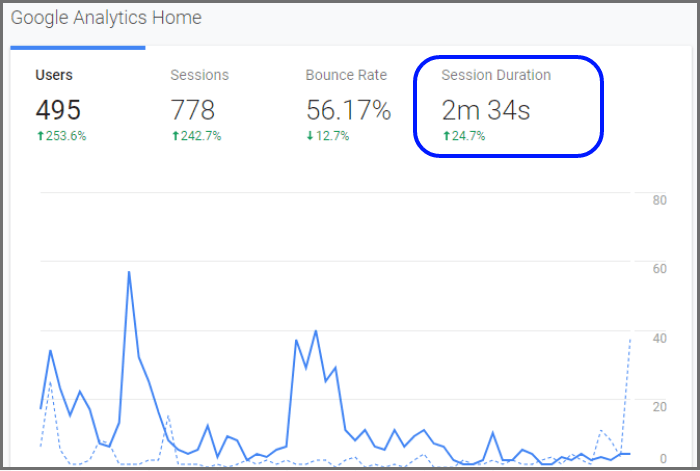
Some of the important data provided by Google Analytics are:
- Pageviews
- Sessions
- Avg. Session duration
- Bounce Rate
- New Sessions
- Behavior
- Acquisition
- Conversions
There are also many other types of data provided by Google Analytics, but when you are starting a blog from scratch, the above-mentioned ones are enough.
These data will not only help you figure out which of your blogs are becoming popular but will also be helpful when you sign up for an affiliate program.
TIP: You can also set up Google Tag Manager account to track your links and other advance data.
This is actually very simple, but if you’re not comfortable, then you can ask a developer to do this for you.
To learn how to Setup Google Analytics account follow this guide from hootsuite.
Step 10: Setting Up Google Search Console
Google search console is a set of tools offered by Google to help website owners to monitor, index, and to improve the website performance for Google SERP.
Google webmaster plays a very crucial role to index your website in search results. Adding your website to Google search console helps Google to index your site.

Search Engine bots automatically crawl your website with the reference of sitemap provided by you.
For detailed guide, visit the link below:
It helps you to better understand search engine metrics like the average position of your blog post, CTR, and impressions.
Google Webmaster also helps you to find search engine penalties, website speed, and AMP issues on your website.
Step 11: How to Make Money?
We’ve talked a lot about setting up your blog and writing and sharing.
And now we’ve come to the real part which you are looking for.
How to earn money from blog? And how much money you can earn from your blog?
If you sell a service or want to build your career as a freelance, then you can use your blog as proof of your expertise and credibility.
This is how some people earn millions of money from blogging.
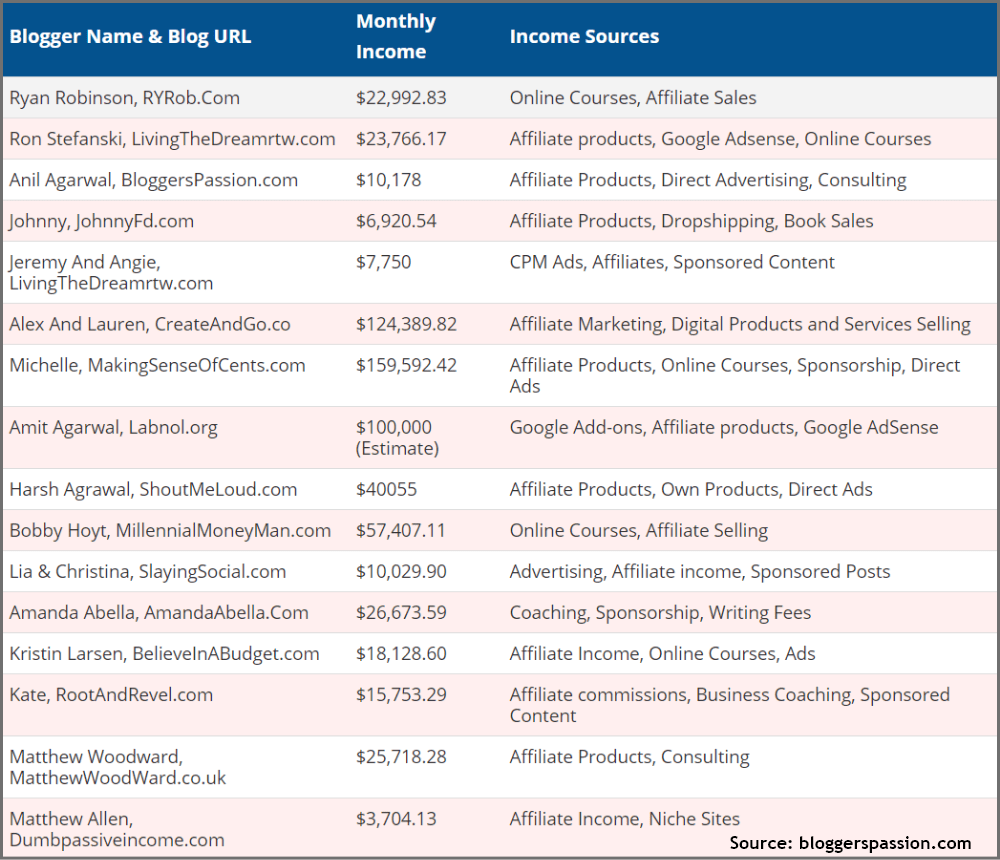
Now let’s see what are different ways to earn money from blog.
1. Google Adsense:
This is the easiest monetization option available for you.
The best thing about Google Adsense is that all you have to do is sign up and choose what type of ads you want to show.
After this, Google will give you an HTML code which you have to paste at the desired location.
Let’s see some pros and cons of Google Adsense:
- No Cost of Joining.
- Easy To Use.
- Customizable Ad Units.
- Moderate Income
- Low CTR.
- Threshold System.
- High Chance of Rejection/Ban.
- Poor Design
Despite low revenues, Google Adsense is very good and the easiest option for earning money from blogging.
2. Amazon Affiliate (Associate):
The advantage of being an Amazon Associate is that you can hope to get high revenues.
Amazon doesn’t go for pay per clicks but conversions, and it pays you in the form of commissions.
Generally, the commissions range from 3 to 6 per cent.
This may not sound so high, but if people end up buying expensive things promoted on your account, then you also earn a high commission.
- High Range of Products.
- Customer Support Service.
- Minimum Payout Threshold.
- Low Affiliate Commission.
- Cookies last for 24 hours.
- Limited Payment Options.
Also, it is not necessary that people have to buy exactly the things displayed on your site.
The point is that they have to visit Amazon through your site, and whatever they end up buying will earn you commissions.
3. Promoting Digital Products:
You can also earn money from blogging by promoting digital products.
The advantage of digital products is that they provide a high commission because of low overhead costs.
I mostly promote product like Web Hosting, WordPress Themes, and SEO tools.
To generate revenue from Adsense or Amazon affiliate you need a huge amount of traffic. But if you’re targeting a specific group of peoples you can generate thousands of dollars from a few monthly visitors.
- Huge Revenue.
- Recurring Payment.
- Targeted Traffic Needed.
- Hard to collect leads.
- Hard to convert leads into sales.
- Minimum Thresholds.
Bonus: Search Engine Optimization
While social sharing and paid marketing are short term strategies when you start the blog, Search Engine Optimisation is a long term strategy.
The reason why SEO is important is that
- High Traffic
- Increase in Sales
- Brand Promotion
- High Revenue
- Authority & Audience
The only downside is that it takes time, but that’s life, isn’t it? Good Things Always Take Time.
On-Page SEO:
On-Page SEO is about optimizing your blog and pages so that search engine bots will find it promising.
The plugin you will need for your wordpress blog is Yoast SEO or RankMath SEO.
Its purpose is to analyze your blog post and pages which are good and bad from the SEO perspective.
Generally, SEO plugins gives you suggestions related to:
- Focus Keyword Density
- Passive Voice
- Length of the Content
- Permalink and slug of the URL
- Subheading and Images
- Readability score
- Internal and External Linking
Based on the suggestions, you can modify your blog.
Providing internal (to other blogs on your website) and external (other websites) links suitable also gives the search engines a message that your content is reliable.
Another aspect of On-Page SEO is the website loading speed. Search engines always prefer websites which load faster.
Websites such as GTmetrix and Pingdoom helps you to analyze website speed and gives you suggestions.
Off-Page SEO:
Off-page SEO is actually about the promotions of your blog posts.
The more your blogs get shared and receive backlinks, the better they rank in search results. Facebook share, twitter share, medium share etc. all add to your Off-Page SEO.
However, if you receive a link from a reputed and high authority blog, then your website rank enhances greatly.
But you should ensure that the links you receive are authentic. i.e “dofollow” with proper anchor text.
Search engines can detect unreliable and paid links. Such practices will not only deteriorate your website rank but can also make search engines penalize you heavily.
It’s okay if you don’t have so many backlinks when you have just started the blog, but regularly bringing valuable contents will eventually pay off in a better way.
Conclusion:
Congratulations! You’ve learned how to start a blog from scratch and how to make money blogging.
Now it’s time to write some awesome content, promote it and generate revenue from it. Also, read some of my handpicked guide for you that will help you further to learn advance techniques.
- How to Improve Search Engine Ranking.
- How to Generate Leads.
- How to Write a Blog Post.
- How to Speed Up WordPress Website.
- Best WordPress Plugins.
- Best SEO Friendly WordPress Themes.
